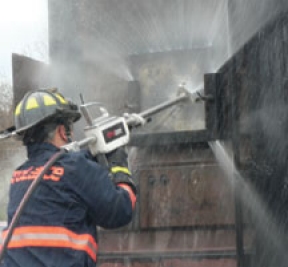by Ed Ballam, Fire Apparatus magazine, 05/01/2008
“PyroLance, based in Denver, Colo., demonstrated a fire suppression system that uses a high-pressure jet of water mixed with a proprietary abrasive material to penetrate steel and concrete up to 3/4-inch thick – or thicker depending on the material – and then delivers a cooling flow.”
A Very Small Hole
“The concept behind PyroLance is to make a very small hole in a contained structure to avoid the introduction of large amounts of oxygen to feed the fire and deliver atomized water to substantially cool and control the thermal layers of fires, reducing the risk of backdraft or flashover. Once the fire has been cooled by the PyroLance, firefighters can enter the structure and extinguish the remaining fire with conventional equipment and tactics.
“This system allows firefighters to make a safe, defensive interior attack,” Spencer said, noting that the system delivers water directly into the thermal column, allowing rapid containment of the fire.
Spencer said the new system has received a great deal of attention recently. He and his crew were leaving directly from FDIC to conduct testing for military applications. “We’re very excited about the opportunity,” he said.”
Mitch: This article really caught my eye as most of my research has focused on the forced entry techniques of firefighters, this technology however allows firefighters to fight fire through barriers which is an exciting approach. Not having to open a door could be the difference between ending a fire and exacerbating it through the introduction of fresh oxygen and a blast of new pressure. This approach however would be quite niche however as engine crews must still also make entry to evaluate a structure and assess the fire. I could envision this being employed by ladder crews to attack hotspots identified by FLIR which were otherwise inaccessible to engine crews. Additionally this would be a good preemptive strike against a fire before crews affected entry to a building, though admittedly with most crews being so short handed and the engine being the first on scene in most cases this would have limited implementation.




